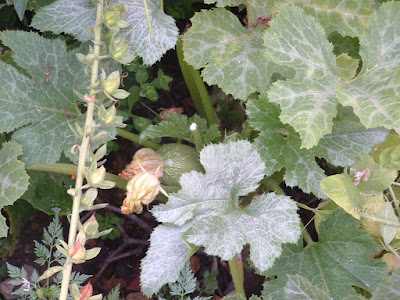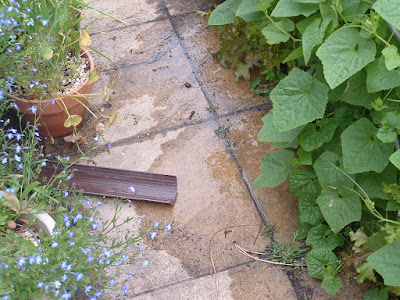 |
| Small but tasty, June 2018 |
Roots
Celery growing well, especially on the side of the bed where the chickens overwintered (extra manure).
Still no evidence of scorzerona, first or second sowings. A few more beet seedlings appeared from another sowing early in June, but pretty sparse; picked one good sized beet as it was trying to bolt: yum.
Harvested a few good finger sized carrots--that's about as big as they get in their planters. Still plenty to come.
Onions and leeks still pretty small; been giving them bi-weekly doses of diluted urine (the celery has been getting it too). Shallots also small. None harvested yet.
Harvested the garlic in June, as the leaves were turning yellow and the stalks falling over--maybe knocked over by a cat or hedgehog--but figured they weren't going to grow any more in that condition. Bulbs smaller than last year, but still acceptable; will save the largest for planting out in autumn, but have been eating the smallest all through the month. Left them to cure on trays in the garage for two weeks, and are now in a cupboard in my kitchen: 99 bulbs (not including a few tiny one-clove bulbs).
Peas and beans
Harvesting broad beans all through June--all eaten as young whole pods.
Only a small amount of early peas harvested--about a quarter of the seeds sown grew into plants; ate them all out of hand without weighing (probably no more than 1-2 oz total). Cleared them away and sowed this patch with pre-sprouted snap peas, some of which popped up by the end of June.
First batch of snap peas very bushy and harvested some nice little pods this month. Harvesting small amounts of mange tout peas all through June--mainly eaten raw in salads. Started harvesting maincrop peas at the end of the month; probably won't be growing these kind of peas (normal podded peas) next year: too labor intensive to harvest and prepare.
Put up supports for runner beans, which had climbed to the top by the end of the month, with a few flowers forming at the end of June. A few flowers also appeared on earliest sown French beans by the end of June. After clearing away the last spring sweetheart cabbage, sowed another small batch of pre-sprouted French beans, which started coming up at the end of the month.
Sowed a small batch of pre-sprouted asparagus peas, but only a few appeared by the end of June (been a hot, dry month and I think this has affected germination of all the beans).
Brassicas
Finally finished the last of the spring sweetheart cabbages in June, and as mentioned above, resowed their space with French beans and asparagus peas.
Brussels sprouts and red kale under insect mesh both straining to escape! Really big, but not ready for harvest yet (or safe to take the mesh off: butterflies fluttering about all this month).
At least two purple sprouting broccoli cuttings rooted, with some of the others still alive, though not sure about roots yet. Planted out two kale cuttings from May, both growing strongly, though not sure if they'll go straight to flower. Took a few more cuttings of kale and broccoli.
Potted on Savoy cabbage, cauliflower and purple sprouting broccoli seedlings; all put under insect mesh (this one is actually a net curtain bought from a charity shop). All growing strongly on my patio table.
Radishes sown earlier are either bolting or wilting: none formed any good roots, probably from hot, dry conditions. Not sure about kohlrabi or the few turnips in this bed either. Turnips in the old chicken yard growing nice roots, however (lots of manure in this bed, and it's in partial shade); harvested some of the biggest ones at the end of the month.
Last winter's remaining Savoy cabbages forming heads now; have picked off a few caterpillars, and one was stricken with aphids. Luckily the sparrows have now completely cleaned off all aphids and it seems to be recovering nicely. Harvested a couple outer leaves this month.
Harvested three cauliflowers (from a planter) at the beginning of June, with the remaining three (in the main Brassicas bed) forming good heads at the end of the month.
Miscellaneous
Last year's chard now fully flowering; have pulled up some, but left about 15 to set seed. New season chard now ready for harvest: picking a little for salads and stews.
Red leaf lettuces growing very strongly this month, and producing enough to pick small salads twice or more a week. Planted out a second batch: some in the ground, and a few in large pots and planters.
Harvested a couple new season spring onions, and the rest growing well--all these in planters. Letting bunching spring onions establish before harvest, and these are growing even bigger than the non bunching ones.
Lost one sweetcorn plant: down to five total, though growing strongly. Lost a few tomatillos, and the rest are a bit spindly still, but growing. Tomatoes growing well: cherry tomatoes flowering with a few green fruits formed at the end of June, and regular tomatoes just beginning to flower.
Zuccinis, squashes and pumpkins (I mixed them up in the bed and can't tell them apart now!) growing new leaves, and a few making flowers but no fruit yet. Found a couple volunteer squashes, growing well with the turnips in the old chicken yard (I think they're squash anyway).
Planted out late-sown cucumbers by the second week of June--some in the ground and some in planters--just starting to grow by the end of the month. Also planted out my one melon seedling in a planter on the patio, but my hopes aren't high: growing, but still very small.
Peppers in planters growing bigger, but no flowers yet. Began watering them (and tomatoes/cucumbers in planters) with manure tea once or twice a week: water which had dried chicken poo soaking in it for a day or two.
Aztec broccoli (not true broccoli) up and growing, but still a bit small. Achocha getting very bushy now, and trying to smother its immediate neighbors (a volunteer potato, lettuce and the sweetcorn), though no flowers yet. Keep adding new stakes to encourage it to grow up instead of out.
Fruit
Harvested all the strawberries this month (birds and slugs had some too). A few raspberries by the end of the month, with lots more green ones to ripen.
Too many redcurrants: mostly eaten out of hand, but some given away or eaten by neighborhood children. Finally finished them by the end of June. Brought the blueberries (in pots) inside at the end of June, just as the berries started turning blue, to protect from birds.
Netted both the Morello and Kordia cherries, and picked all the Morellos to freeze: eight year old wants a pie but it'll be a small one. Started picking Kordia cherries at the end of the month--they're bigger than the Morellos but fewer of them.
Picked all the blackcurrants at the end of the month--not as many as last year, but the bushes had some damage from the felling of the sycamore tree in January. Gooseberries still a little hard, and whitecurrants still green this month. Autumn raspberry tall and leafy, but no flowers yet.
Peach aka nectarine tree has two fruits still growing on it. Figs glorious and still green; Williams pear has just a couple fruits that I can see. Almond tree has tons of almonds; Sparta apple has shed some immature fruit but both it and Laxton Fortune are still well covered in little apples.
Perennials and herbs
Harvested small amounts of parsley, chives, savory, and dill all through this month. Picked a big bunch of mint to make a jar of mint sauce; hoping it puts out a similar amount of growth next month so I can make another! Discovered some self-seeded camomile--last year's batch either didn't survive the harsher-than-usual winter, or was scratched up by chickens (still have half a jar of dried leaves and it's way more powerful than any I've ever bought).
Rhubarb looks like it's dying back--hopefully not actually dying. Asparagus not much bigger than last month, though still growing.
Harvested my first artichokes: none bigger than walnuts, but they were starting to open, so I figured I better have them; they were delicious after cooking whole and marinating (trimmed off the sharp tips first). A few more buds forming at the end of June, but doubt they'll be any bigger.









